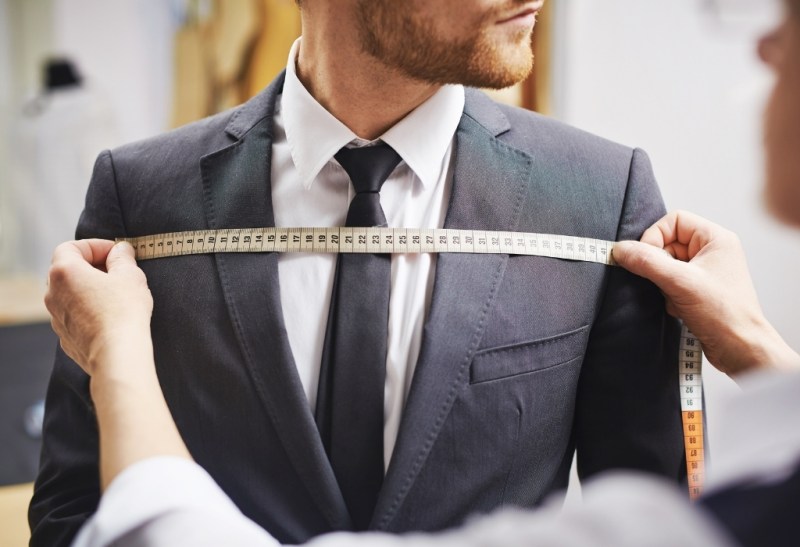Wearing a suit may have gone out of style there for a bit, thanks to the casualization of the world. But they are steaming back with a vengeance thanks to the return of vintage style. Of course, that doesn’t mean it’s as simple as throwing on a coat and tie and calling it good, which may have been a reason for the downfall. There is a science to looking great in a suit.
If you wear a suit everyday, you may already be up to date on the changing trends, but if you’re new to the style or been away, it can be a little confusing. To help you avoid any awkward fashion conversations, we took the time to compile some essential rules for how to wear a suit. Below is a simple, condensed cheat sheet that you can easily refer to whenever you find yourself neck-deep in a three-piece. Also, if you’re building “your suit wardrobe,” the good news is you only need a few staple suits that will work for any occasion.
There are always exceptions and qualifications for each of these rules, so don’t take them as the end-all-be-all. Adding some personal flair is vital to building your own unique look. Remember that menswear has some rules, guidelines, and moments that allow you to occasionally color outside the lines.
The basics of how to wear a suit

Let’s start with the broad strokes. Wearing a suit can be fairly straightforward once you get the basics down. These tips will keep you from looking out of place, but won’t have you standing out in a crowd. Here are some of the basics for wearing a suit:
- Your belt should be relatively thin, between an inch and an inch and a half. The thinner one-inch belts are for smaller men with a 34-inch waist or smaller. They should also match your shoes and watch (if it has a leather band).
- Your tie bar should be the right length. As a rule of thumb, your tie bar should be over halfway across, but not quite to the other edge.
- Remember the “somedays, always, never” rule regarding the buttons on your suit. On a three-button suit, the top button is sometimes buttoned when standing, the middle is always done, and the bottom is never buttoned. On a two-button suit, the top button is always done, and the bottom is never done. Vests and cardigans follow the same rules.
- Always unbutton your suit before sitting down. It will pull in all directions if you keep it buttoned when you sit. Not only will it look strained and unflattering, but the buttons can pull off; you never know where they will shoot when under that much strain. This isn’t true with double-breasted suits. These can remain buttoned the entire time you wear it.
- Permanently remove the stitching on the vents and the label on the left sleeve before wearing a new suit.
- Never remove the stitching of the jacket pockets and never use your pockets; they can easily be stretched out, warping the entire suit. The exception to this rule is the breast pocket on the left side of your chest.
The finer points of wearing a suit

Now that you have the basics down and you look passable, let’s dig a little deeper and go for some more deep cuts in the suit world. These are going to be those items that those in the know will take note of, like an acceptance into some club, the good looking guy club. Those who aren’t in the know will think you always look amazing in suits, but they won’t altogether know why. Here is how to enter the club:
- The width of your tie should match the width of your lapel. Thin ties with thick lapels can make one or both look outdated. Ensuring that both are the current in-style will keep you looking like you know what you’re doing.
- Your tie should just reach the waistband of your trousers or the top of your belt buckle. Too long makes you look short and incapable; too short can make you look overweight and disheveled.
- Your suit jacket should be just long enough to cover your pant zipper and the seat of your pants. As the years have gone by, the style has changed to include longer or shorter, but the middle ground will keep you safe year in and year out.
- The top button of a two-button (or the middle button of a three-button) jacket should fall at or above your navel.
- Sleeve cuffs should be exposed about a quarter inch.
- Ensure that your socks are long enough that there’s no exposed leg when sitting down.
- A good tailor can work wonders on a suit that you love, but know it won’t fit or feel like it did before.
Style-savvy tips for wearing a suit

OK, you have made it into the club, now you have gone from the best looking guy outside the club to the amateur inside the club. You need to step it up and stand out in this crowd. Here are the tips that will refine your look and cause you to be the best looking guy in the room, no matter which room in which you find yourself.
- A pocket square adds an extra level of polish, but make sure it doesn’t match your tie in either pattern or fabric choice. Complimenting is better than matching. Matching makes it look like you got it out of a cheap box set.
- Opt for a charcoal or gray suit over black unless you’re attending a funeral or other equally conservative event. Black is too formal for anything at the office nowadays. Save black suits for engagements after 6 pm.
- The pant hem should hit right at the top of your shoe for a more fashion-forward look. Your tailor will call this a no break. A full break will bunch up at the top of your shoes, and will make you look short, and like you’re living in the 90s. This may be something that returns for a short time period in today’s world, but it won’t stay long so if you go for a full break, there is a chance you will have to get it tailored again when the trend passes.
- When you go without a tie, it’s best to keep your shirt collar on the smaller side.
- Double vents in the back are more modern and fashionable.
- Avoid over-accessorizing. If you’re already wearing a pocket square and a tie bar, you’ll want to reconsider that clever lapel pin.
Tips for smart suit shopping

Now you know how to wear a suit. Let’s get outside and start shopping for the right one. If you’re a suiting veteran, you may be able to do it online and save some money. But if you are new to suits, go into a store, find a professional you trust with an on-site tailor, and let them help you find your vision. If you can swing it, your first suit should be a made-to-measure from a professional instead of an off-the-rack version. So you can learn what it SHOULD feel like.
- Choose fabric according to how often you’ll wear the suit. The most versatile option is a soft but durable wool-like Super 120 (a measure of yarn fineness); any higher is too delicate for daily use. Save your Super 150s and Super 180s for weddings and the less often special occasions or important meetings.
- When buying an off-the-rack suit, the first thing to check is how the shoulders fit. A tailor can do a lot with the rest of the suit, but he can’t change the shoulders.
- A collar gap between your jacket’s lapels and your shirt’s collar can signify an ill-fitting jacket.
- Opt for a double-button, notched lapel jacket if you’re going for more formal business attire.
- Opt for a single-button, peak-lapel jacket for a more casual, trendy look.
- You should be able to slip your hand between your chest and your buttoned jacket so that it feels snug but has room to move.
- Visible stitches around the edges of your lapels (called pick-stitching) aren’t necessarily a sign of a well-made garment anymore. However, they can be an attractive decorative flourish — as long as they’re subtle.
The two tailored garments you must have

When you are just starting out, you may be wondering what you should be getting color and style wise. What is going to be the most versatile? What will you be able to wear the most? Eric Powell, Founder of Ratio Clothing, a digital and brick-and-mortar business that custom tailors shirts and suits, says these two suits should be the building blocks of your suit wardrobe:
- Dark all-season solid – “If you only want one suit in your closet, this is the one. This is the all-purpose suit you can wear to weddings, funerals, job interviews, and everything in between. Dark charcoal or navy is the move here — not black. A black suit can look stark in daylight and is generally reserved for service staff uniforms,” Powell said. “Keep things simple on this one with a two-button, notch lapel. A solid fabric will make it versatile, so you can pair it with virtually any shirt or tie. We like a Super 110’s or Super 120’s gabardine that will be comfortable to wear in any season.”
- Navy blazer – “Not a suit exactly, but these days the situation often calls for something less than a full suit. The navy blazer is your friend when the formality is unclear or if you want to kick your casual wear up a notch. Wear them with jeans or your finest wool trousers. Throw on a tie. Or not. If you wear a navy blazer, you’ll rarely be underdressed or overdressed,” Powell explained. “We like a travel-ready fabric like hopsack for your navy blazer. Connoisseurs will often go with an unconstructed model for their all-purpose blazer. This keeps things less rigid, literally and figuratively, and will be comfortable for long days that take you from the office to an evening on the town.”
The five-suit rule

It’s important to have a variety of suits in your wardrobe, as wearing the same suit daily can become a monotonous fashion faux pas. Remember the five-suit rule, which states that every man needs to own a black, navy, gray, brown, and tan suit.
These colors complement each other well, giving you a wide range of versatile options for any occasion. Having a variety of different suits guarantee you’ll always have something fresh and fashionable to wear anytime, and you can experiment with various combinations and styles to look your best. Break free from the boring everyday suit and level up your style with a diverse suit collection.
This should get you started on building a stellar wardrobe with quality, fit, and versatility. No matter who you are and your lifestyle, every man needs a fitting suit. Follow these tips, and you will be the best dressed man at the office or in any casual setting or social event.




